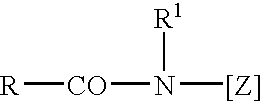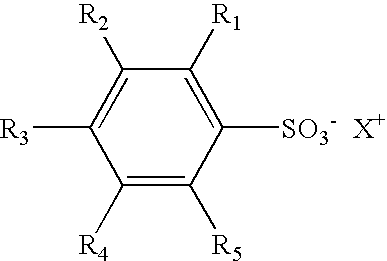Cleaning compositions for glass surfaces
a technology for cleaning compositions and glass surfaces, applied in detergent compositions, detergent compounding agents, chemistry apparatus and processes, etc., can solve problems such as cloudiness, scratches, smears, etc., and compositions known from the prior art are not fully satisfactory
- Summary
- Abstract
- Description
- Claims
- Application Information
AI Technical Summary
Benefits of technology
Problems solved by technology
Method used
Image
Examples
examples
1. Production of a Six-Arm Triethoxysilyl-Terminated Polyalkoxylate
A polyether polyol was used as the starting material which represents a 6-arm statistical poly(ethylene oxide-co-propylene oxide) with an EO / PO ratio of 80 / 20 and a molecular weight of 12 000 g / mol. It was manufactured by anionic ring-opening polymerization of ethylene oxide and propylene oxide using sorbitol as the initiator. Prior to the further reaction, the polyether polyol was heated to 80° C. with stirring under a vacuum for 1 h. To a solution of polyether polyol (3 g, 0.25 mmol), triethylenediamine (9 mg, 0.081 mmol) and dibutyltin dilaurate (9 mg, 0.014 mmol) in 25 ml anhydrous toluene was added drop wise a solution of (3-isocyanatopropyl)triethoxysilane (0.6 ml, 2.30 mmol) in 10 ml anhydrous toluene. The solution was stirred overnight at 50° C. After the toluene had been removed under vacuum, the crude product was repeatedly washed with anhydrous ether. After drying under vacuum, the product was obtained as ...
PUM
| Property | Measurement | Unit |
|---|---|---|
| weight fraction | aaaaa | aaaaa |
| temperatures | aaaaa | aaaaa |
| composition | aaaaa | aaaaa |
Abstract
Description
Claims
Application Information
 Login to View More
Login to View More - R&D
- Intellectual Property
- Life Sciences
- Materials
- Tech Scout
- Unparalleled Data Quality
- Higher Quality Content
- 60% Fewer Hallucinations
Browse by: Latest US Patents, China's latest patents, Technical Efficacy Thesaurus, Application Domain, Technology Topic, Popular Technical Reports.
© 2025 PatSnap. All rights reserved.Legal|Privacy policy|Modern Slavery Act Transparency Statement|Sitemap|About US| Contact US: help@patsnap.com



